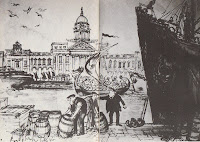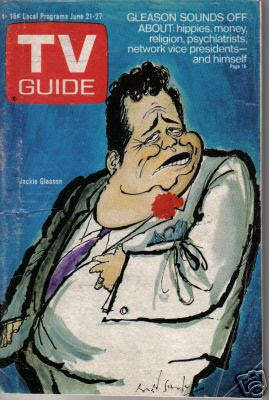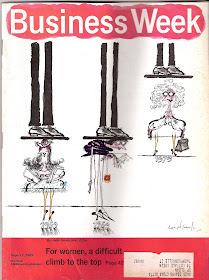
'One man's humor'
Some people are born wry. British cartoonist Ronald Searle is probably one of them. "Ronald Searle: Satirist," in the Cartoon Library & Museum at Ohio State University, offers a tantalizing taste of his talent.
 Searle gained prominence in the 1950s and '60s, an era featured in several exhibit illustrations drawn in ink and in ink and watercolor. Dublin, published in a 1963 issue of Holiday magazine, is a cartoon view of the Dublin, Ireland, harbor as a Viking ship arrives -- to the consternation of Dubliners.
Searle gained prominence in the 1950s and '60s, an era featured in several exhibit illustrations drawn in ink and in ink and watercolor. Dublin, published in a 1963 issue of Holiday magazine, is a cartoon view of the Dublin, Ireland, harbor as a Viking ship arrives -- to the consternation of Dubliners. An illustration for a 1966 issue of TV Guide shows Bewitched star Elizabeth Montgomery sitting in a powder room, where a makeup artist is lowering a mask with Montgomery's attractive facial features over Montgomery's head, which is portrayed with the face of a hag.
An illustration for a 1966 issue of TV Guide shows Bewitched star Elizabeth Montgomery sitting in a powder room, where a makeup artist is lowering a mask with Montgomery's attractive facial features over Montgomery's head, which is portrayed with the face of a hag."His style is very loose yet precise," Lucy Caswell, curator of the library and museum, said of the 88-year-old. "You have the feeling it's a very sure hand."
Perhaps it's surprising that he kept his sense of humor. A member of the British army, Searle was captured by the Japanese when Singapore fell in 1941 during World War II. The British prisoners were among the forced-labor pool that built the railroad made famous in the film The Bridge on the River Kwai. In secret, Searle made illustrations while a prisoner.
"I gather that it was his art, in many ways, that saved him and his sanity," Caswell said. After the war, Searle was a cartoonist for Punch, a British humor publication -- which served as a jumping-off place for his career. In illustrations, he created St. Trinian's, a fictitious boarding school for girls that was featured in books and films. He illustrated humorous books on everything from cats to wine. "He's part of that long British tradition of looking at the world wryly," she said.

In 1995, the cartoon library and museum bought four dozen Searle pieces. "We rarely purchase art," Caswell said. "Because of his status, I thought it was important to purchase some of his work so that students can see it." And the rest of us, too.
The exhibit continues through March 31 at the OSU Cartoon Library & Museum, 27 W. 17th Ave. Mall.
Hours: 9 a.m. to 5 p.m. weekdays. For more information, call 614-292-0538 or visit www.cartoons.osu.edu.
This article written by Bill Mayr for The Columbus Dispatch, Thursday, January 29, 2009

Here is a list of the drawings in the exhibition. I'll try to find the relevant images for Searle fans who can't make it to the show.

[Self-caricature] Berlin, November 1989.
Mark J. Cohen and Rose Marie McDaniel Collection.

[Spanish Steps in Rome] illustrated an article
in Holiday, December 1954.

Palais des Nations—Geneva was one of several drawings of the Big Four Conference by Searle
in the November 7, 1955 issue of Life.
A Nobleman in Reduced Circumstances was published in the January 15, 1958 issue of Punch.

Refugees selling rations to the local population is one
of several drawings reprinted in Ronald Searle in Perspective (London: New English Library, 1984) described as “notes from a journey made for the United Nations High Commissioner for Refugees.” It was also reprinted in Refugees 1960 by Kaye Webb (Harmondsworth: Penguin, 1960). This drawing was made at the Sversa Refugee Camp near Naples, Italy, on November 14, 1959.

[Peaceable Kingdom]. 1960. This is an unpublished parody of Edward Hicks’ painting The Peaceable Kingdom.

Fremont Street, Las Vegas was published in the June 1960 issue of Holiday.
Brennan’s Restaurant, New Orleans, Bourbon Street from the Old Absinthe House, and Decatur Street, New Orleans were published in the July 1960 issue of Holiday.
[Milan] was published in the February 1963 issue of Fortune.
 Dublin was published in the April 1963 issue
Dublin was published in the April 1963 issue of Holiday.

Complexe Chimique de Aquitainchimie Usine de Parties, Bassy, Pyrenees appeared in the November 1963 issue of Fortune.

For the 1964 UNICEF film Grain of Sand, the African child and the two Indonesian children were among the drawings by Ronald Searle that accompanied the narration of William Blake’s poem of the same title.
[Florida Pavilion], [Kodak Pavilion] and New York World Fair Peace Through Understanding illustrated
an article about the 1964 New York City World’s Fair published in the July 1964 issue of Holiday.
[Football players] appeared in the April 7, 1964 issue of Look.
 [Bob Hope] was the cover illustration of the January 16-22, 1965 issue of TV Guide.
[Bob Hope] was the cover illustration of the January 16-22, 1965 issue of TV Guide.
Searle’s drawings of Oahu and Waikiki
were published in the December 1965 issue
of Holiday.

Prince Phillip visited the United States in the spring of 1966 and these drawings were published in the April l5, 1966 issue of Look.
 David Janssen starred in the television program The Fugitive which was featured in the January 22-28, 1966 issue of TV Guide.
David Janssen starred in the television program The Fugitive which was featured in the January 22-28, 1966 issue of TV Guide. Elizabeth Montgomery starred in the television program Bewitched which was featured in the
Elizabeth Montgomery starred in the television program Bewitched which was featured in the June 18, 1966 issue of TV Guide.
[Australian race crowd] was published in the October 31, 1966 issue of Sports Illustrated.
 [Ed Sullivan] was created for the June 1-8, 1968 issue of TV Guide.
[Ed Sullivan] was created for the June 1-8, 1968 issue of TV Guide.
 [Jackie Gleason] was the cover illustration of the June 21-27, 1969 issue of TV Guide.
[Jackie Gleason] was the cover illustration of the June 21-27, 1969 issue of TV Guide.
[Working women] ran in the August 1969 issue of Business Week.
"The cover blurb reads "The route to executive status: For women, a difficult climb to the top." Today we would call this idea "the glass ceiling." From the illustration, it looks as if Searle all but anticipated the phrase. (According to the website wisegeek.com, the term was first used in Adweek in 1984.) It is particularly remarkable how Searle handled the third panel, having the projected woman of 1979, now fairly elderly, finally achieving an increase in her stature, only to have the male-dominated upper floor rise still higher.
As you can see, Searle's orange color field across the bottom was replaced by a plain red strip banner. That's why we have art directors."
-Stephen Nadler

[Military intelligence] is an unpublished drawing from the 1960s.
"In fact, the drawing appears on page 72 of the April 1962 issue of Holiday in the article "Lots to See in Town" on Washington, D.C. Searle's British spelling of "authorised" would never be tolerated in the Pentagon and is corrected with a z in the magazine. The drawing also appears in From Frozen North to Filthy Lucre on page 85 with Searle's s improbably restored, although I believe traces of glue over the letter are now visible."
-Stephen Nadler
'Ronald Searle: Satirist showcases examples of this great British cartoonist’s work at the height of his career as a graphic reporter during the 1950s and 1960s. Born March 3, 1920, to a working class family in Cambridge, Searle quit art school to join the Territorial Army as an Architectural Draughtsman in 1939. He was shipped to Singapore in October 1941, was captured by the Japanese a month after his arrival, He spent the remainder of World War II in a prisoner of war camp. Searle began cartooning for Punch in 1946 and was so successful there that he became a member of Mr. Punch’s Table, a very high honor, only a decade later. During this time, Searle also worked frequently for American magazines such as Holiday and Life. In 1960 he was the first non-American artist to receive the National Cartoonists Society’s Reuben Award, its highest honor.
In the early 1960s Searle moved to France and began cartooning less and painting more. He created several limited edition prints over the last forty years. Searle collaborated on numerous book projects, as documented by the eighty-four titles associated with him that are held in this library.
The Cartoon Library and Museum was fortunate to purchase a collection of almost fifty pieces by Searle in 1995. Most of the works in this exhibition are selected from this purchase.'
(OSU website)








No comments:
Post a Comment